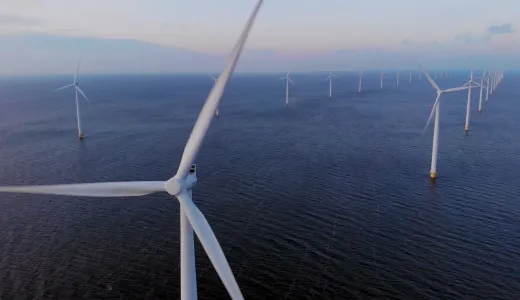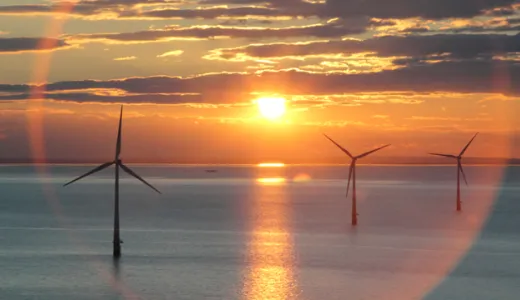Learn about offshore wind power on the UK’s East Coast and the planning process for future infrastructure. We’re committed to enabling a fair and affordable transition to a clean energy economy, while delivering positive impact in the communities we serve.
Offshore wind is a way of harnessing the potential of the North Sea for electricity generation. The government’s Energy White Paper in December 2020 sets a target to deploy 40 GW of offshore wind by 2030 – enough to power every home.
Demand will grow as we shift to clean energy to drive electric vehicles, heat our homes and power our industries. The Climate Change Committee advises the UK needs over 75 GW to meet net zero by 2050.
This unprecedented level of offshore wind – four times more than the world leading levels we have today – will require major development of both the onshore and offshore electricity networks to accommodate it.
When developing transmission network proposals, we have a statutory duty, under the Electricity Act 1989, to act in an efficient, coordinated and economical way, and have regard to the desirability of preserving amenities.
When considering options to deliver additional network capability, we must balance the need to develop the network in a way that is efficient, coordinated and economical, and minimises impacts on people and places.
The National Energy System Operator (NESO) leads an annual process that looks at network capability requirements with input from Transmission Owners. This process identifies deficiencies in the future network and provides cost effective solutions to rectify those, in line with the framework set by government and Ofgem, the regulator.
Nationally Significant Infrastructure Projects (NSIPs) are major infrastructure developments in England and Wales. These include projects such as power plants, large renewable energy projects, new airports, airport extensions and major road projects.
A Development Consent Order (DCO) application for consent to undertake an NSIP is made to the Planning Inspectorate, who will consider the application and make a recommendation to the Secretary of State. The minister will decide on whether development consent should be granted for the proposed scheme.
The process comprises six key stages:
- pre-application
- acceptance
- pre-examination
- examination
- decision
- post-decision.
On receipt of an application for development consent, the Planning Inspectorate has 28 days to decide accept it or not. There is a period of six months for the Planning Inspectorate to examine an application and three months for the Planning Inspectorate to make its recommendation to the Secretary of State. The Secretary of State has a further period of three months in which to issue a decision. The whole process should take about 15 months.
The Planning Inspectorate encourages dialogue between local authorities affected by an NSIP. Ultimately, it is for the particular local authority to judge how best to respond to the Planning Inspectorate. However, if several local authorities are affected by a proposal, they may wish to discuss and co-ordinate representations to convey their views.
National Grid charges both generators and supply companies for connection to and use of the transmission system. National Grid’s charging methodology is approved by Ofgem, the energy regulator. The cost of building a new connection is picked up by National Grid. During planning and construction of new transmission infrastructure, security for the cost is shared between the generating companies who will ultimately benefit from it.
The money is recouped by National Grid over 40 years through charges made to generators and suppliers who use the line to transmit electricity. These charges pass through to consumers in their bills and are regulated by Ofgem.
National Grid is currently investing around £1.3 billion a year in our electricity network. We need to raise that money up front from investors and lenders. Electricity consumers pay it back in their bills over some 40 years. Electricity transmission costs make up around 4% of the typical electricity bill.
Several route corridors and options are considered within an area of search Our appraisal options consider:
- Environmental: landscape and visual amenity; ecology; historic environment; local air quality, noise and vibration, soils and geology, water
- Socio-economic: economic activity traffic and transport; aviation and defence
- Technical: technical complexity; construction/project delivery (including resource use and waste); suitability of technology; network capacity; network efficient/benefits
- Cost: capital cost and lifetime cost
Our Route Corridor Report then explains the options that have been considered and why we feel a that chosen option is the right one to take forward.
We are committed to using proven up-to-date technologies to manage the network and in new proposals. Before we add to the transmission network, we first look at ways in which we might get more power- carrying capacity from the existing network.
At the beginning of each project and as we plan the work, we carefully consider potential environmental effects to make sure that we minimise or avoid potential impacts on the environment as much as we can.
We will be consulting with the local councils in Suffolk, Essex and Kent, with the Environment Agency, Natural England, Historic England, the Wildlife Trusts, local environmental groups and landowners. What these groups tell us and the feedback we receive through the consultations will help us to carefully plan our proposals and how we carry out the works.
The government has shown a clear commitment to developing further offshore wind at scale and we welcome the Government’s Offshore Transmission Network Review, which seeks to address current challenges. It is important the review moves at pace and we fully support that.
But if the government wishes to achieve 40 GW of electricity generation from offshore wind by 2030, there are essential network reinforcements, which we now need to proceed with under the current policies and frameworks.
The scale of development needed to achieve net zero, including with up to 75 GW of offshore wind connected to the transmission network by 2050, requires careful planning and coordination, alongside significant investment, to ensure the necessary electricity transmission infrastructure is delivered in a way which minimises impacts on local communities.
Tackling climate change offers huge opportunities for job creation and job growth.
The government estimates zero emission vehicles could support 40,000 jobs by 2030 and 40 GW of offshore wind in the same period will support up to 60,000 jobs. Our own analysis in our Job That Can’t Wait report, shows that the country needs to fill 400,000 jobs in the energy sector in the next three decades.
The Eastern coastal regions adjoining the North Sea are perfectly placed to embrace the economic opportunities that these cleaner greener sources of energy will provide with investment, skills, training and real jobs.
Where we are delivering those network investments, we also work with schools and local authorities to encourage the next generation of engineers and help the long term unemployed develop new skills.
Where communities are impacted by our works, we have a Community Grant Programme, where charitable and not- for- profit organisations can apply for up to £20,000 each toward community-based initiatives.

